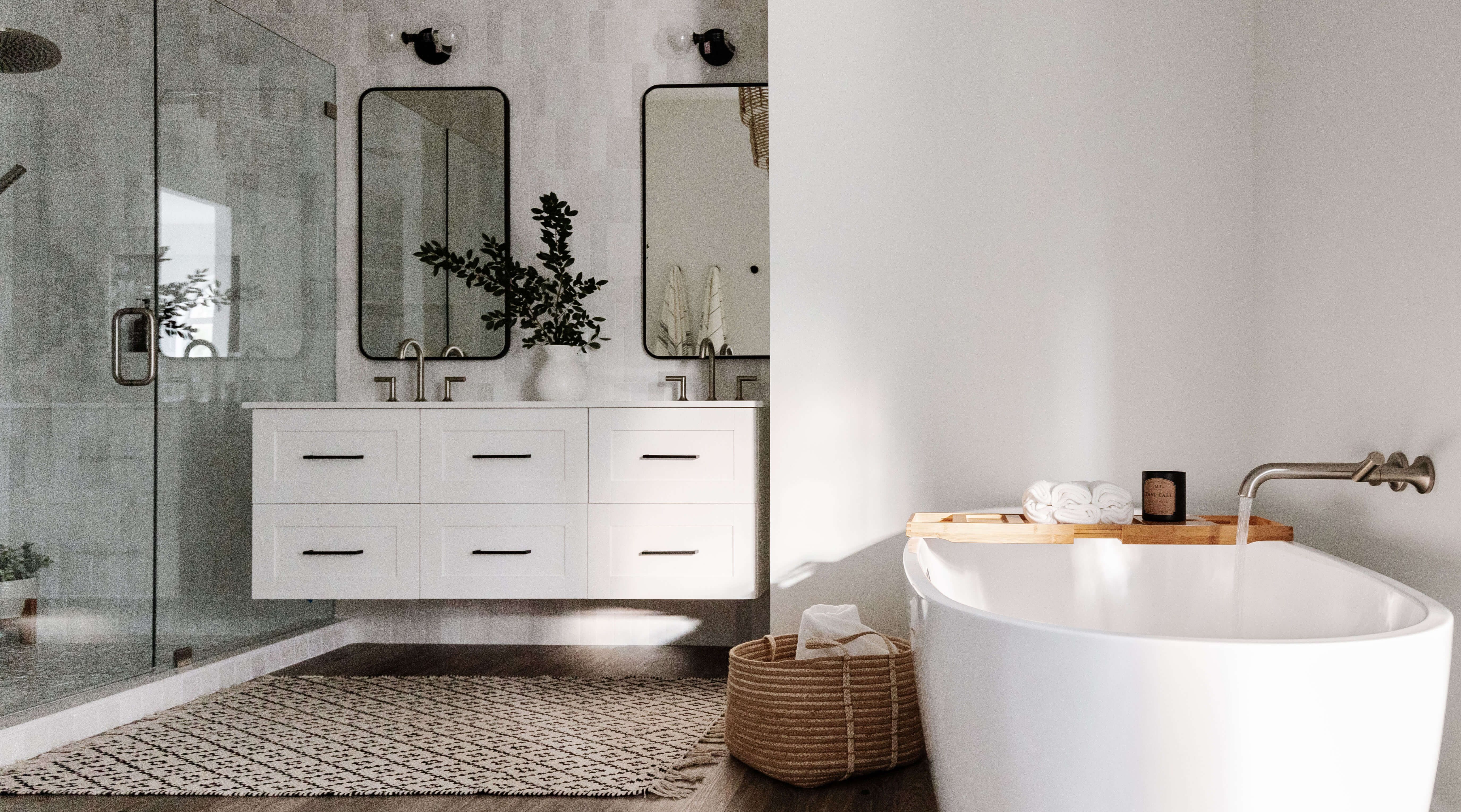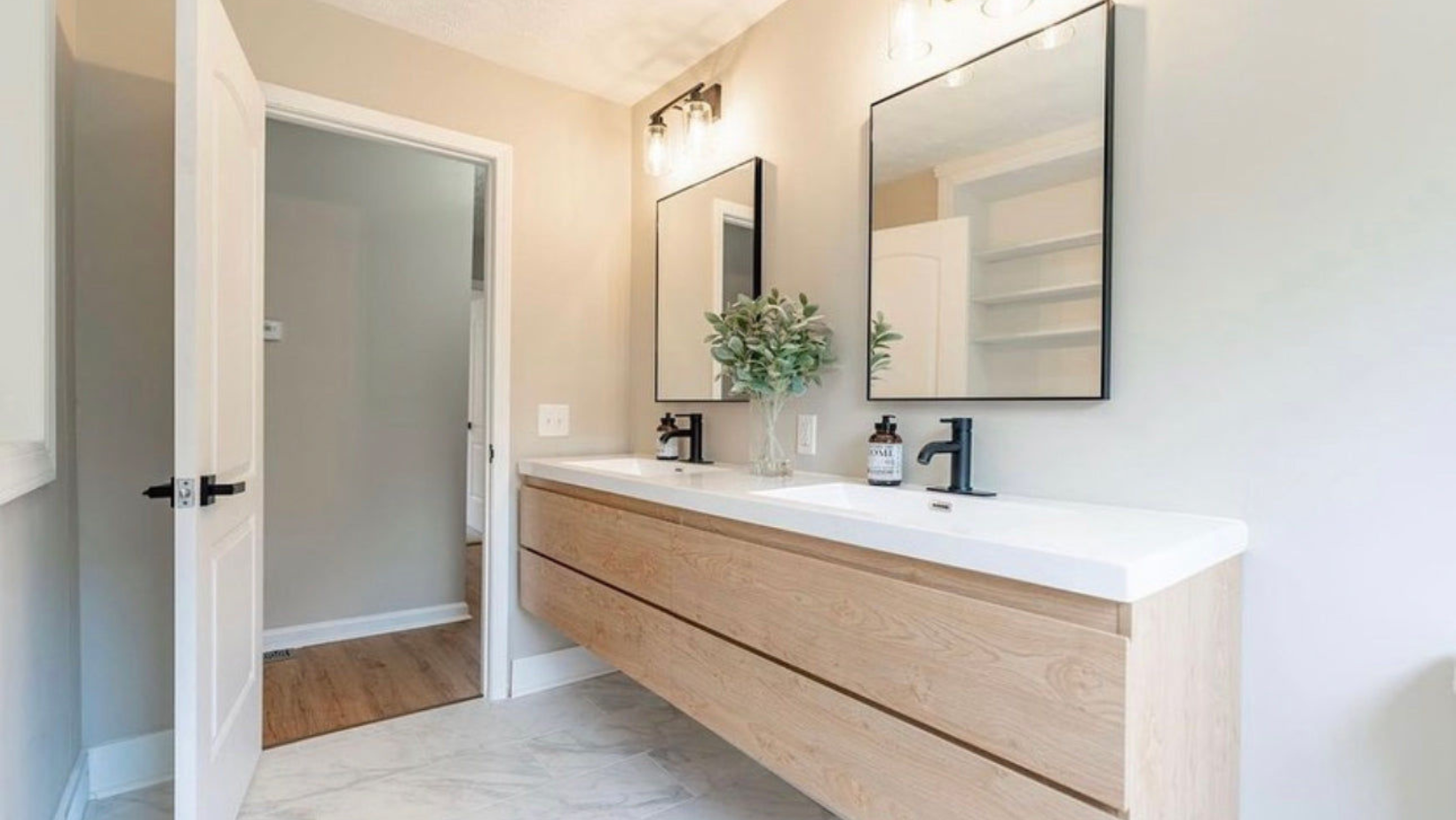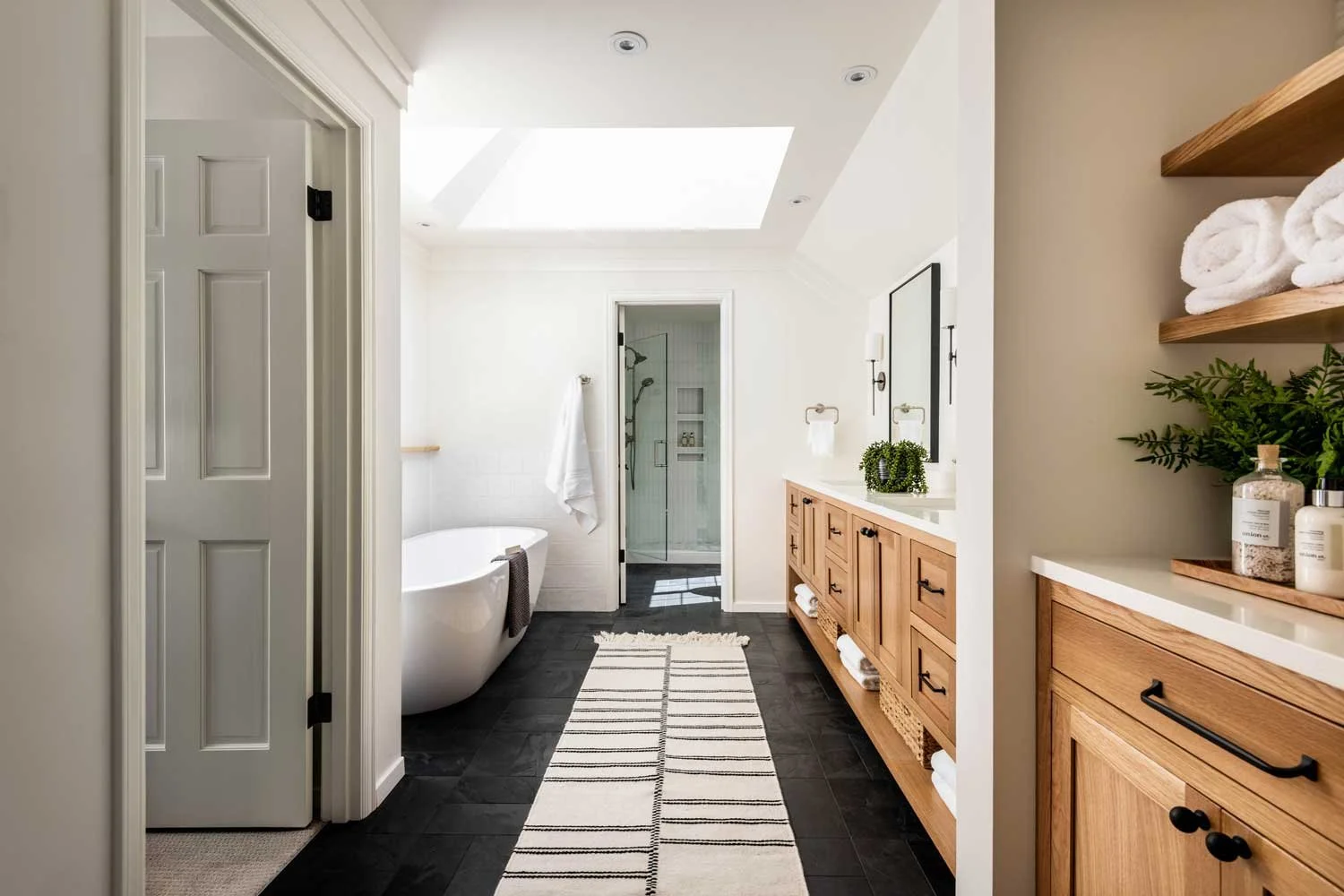Slab Door Bathroom Vanity Styles and Designs

Slab doors are a popular choice for bathroom vanities, offering a sleek and modern look that complements various design aesthetics. They are characterized by their simple, flat surface without any raised panels or intricate details, making them a versatile option for different styles and materials.
Modern Slab Door Bathroom Vanities
Modern slab door vanities typically feature clean lines, minimalist designs, and a focus on functionality. They often use materials like high-gloss lacquered wood, metal, or stone, with sleek hardware like brushed nickel or chrome pulls. The absence of intricate details emphasizes the simplicity and sophistication of the design.
- Example: A modern slab door vanity made from white lacquered MDF with a floating countertop and a brushed nickel pull.
Traditional Slab Door Bathroom Vanities
While traditional vanities often feature intricate details and carvings, slab doors can still be incorporated into this style. They can be achieved by using materials like solid wood with a warm finish, such as cherry or walnut. Distressed hardware or antique-looking knobs can further enhance the traditional feel.
- Example: A traditional slab door vanity made from solid walnut with a distressed finish, a white marble countertop, and antique brass knobs.
Farmhouse Slab Door Bathroom Vanities
Farmhouse vanities are characterized by their rustic charm and focus on natural materials. Slab doors can complement this style by using wood with a natural finish, such as reclaimed barn wood or oak. Hardware can include simple black iron pulls or knobs, adding a touch of industrial flair.
- Example: A farmhouse slab door vanity made from reclaimed barn wood with a natural finish, a butcher block countertop, and black iron pulls.
Contemporary Slab Door Bathroom Vanities
Contemporary vanities often incorporate bold colours, geometric shapes, and unique materials. Slab doors can be used to create a statement piece, with bold colours like black or navy blue, or unusual materials like concrete or metal.
- Example: A contemporary slab door vanity made from black lacquered MDF with a concrete countertop and a geometric chrome pull.
Advantages and Disadvantages of Slab Doors
Advantages:
- Clean and Minimalist: Slab doors create a sleek and modern look, perfect for minimalist or contemporary bathroom designs.
- Versatile: They can be incorporated into various styles, from traditional to modern, by choosing the right materials and finishes.
- Easy to Clean: The flat surface makes them easy to clean and maintain, reducing the risk of dust and grime accumulating in crevices.
- Cost-Effective: Slab doors are often more affordable than other door styles, such as shaker or raised panel doors, as they require less material and craftsmanship.
Disadvantages:
- Less Character: Compared to more intricate door styles, slab doors can appear less characterful and lack visual interest.
- Prone to Fingerprints: The flat surface can be prone to fingerprints and smudges, especially with high-gloss finishes.
- Limited Customization: The simple design offers fewer options for customization, such as intricate carvings or decorative accents.
Slab Doors vs. Other Door Styles
Slab doors are often compared to other popular door styles, such as shaker or raised panel doors.
Slab Doors vs. Shaker Doors
- Shaker doors feature a simple frame with a flat center panel, offering a clean and classic look. They provide a more traditional aesthetic compared to the sleek simplicity of slab doors.
- Slab doors are generally more modern and minimalist, emphasizing clean lines and a streamlined appearance.
Slab Doors vs. Raised Panel Doors
- Raised panel doors feature a raised center panel surrounded by a frame, creating a more ornate and traditional look. They add visual interest and depth to the vanity.
- Slab doors are simpler and more contemporary, offering a sleek and understated design.
Choosing the Right Slab Door Bathroom Vanity for Your Bathroom

Selecting the perfect slab door bathroom vanity is a crucial step in transforming your bathroom into a stylish and functional space. With a wide array of sizes, configurations, and design options available, finding the ideal fit for your needs requires careful consideration. This guide will walk you through the key factors to consider when choosing a slab door vanity, ensuring you make the right decision for your bathroom.
Vanity Size and Configuration
The size and configuration of your slab door vanity should be determined by the dimensions of your bathroom and the desired functionality. Consider the available space, the flow of traffic, and the number of users. A compact vanity might be suitable for a smaller bathroom, while a larger vanity with multiple drawers and cabinets would be ideal for a spacious bathroom.
For instance, a 30-inch wide vanity could comfortably accommodate a single sink and offer adequate storage space for a smaller bathroom. However, a larger bathroom might benefit from a 60-inch wide vanity with double sinks, providing ample counter space and storage for a family.
Countertop Material, Sink Type, and Storage Options
The countertop material, sink type, and storage options are key elements that influence both the aesthetics and functionality of your slab door vanity.
Countertop Material
- Granite: Durable, scratch-resistant, and heat-resistant, granite countertops are a popular choice for bathrooms. Available in a wide range of colours and patterns, granite adds a touch of elegance and sophistication to any bathroom.
- Quartz: Engineered quartz countertops are non-porous, stain-resistant, and easy to clean. Offering a wide variety of colours and patterns, quartz is a practical and stylish option for busy bathrooms.
- Marble: Known for its classic beauty and natural veining, marble countertops are a luxurious choice. However, marble is porous and susceptible to staining, requiring regular sealing and careful maintenance.
- Laminate: Laminate countertops are a budget-friendly option, offering a wide range of colours and patterns. While not as durable as natural stone, laminate countertops are easy to clean and maintain.
Sink Type
- Undermount Sink: Seamlessly integrated into the countertop, undermount sinks create a sleek and modern look. They are easy to clean and offer a larger counter space.
- Vessel Sink: Perched on the countertop, vessel sinks offer a unique and stylish look. They can add a touch of elegance to any bathroom but may limit counter space.
- Drop-in Sink: A traditional and affordable option, drop-in sinks are installed directly into the countertop. They offer a variety of styles and sizes but may not be as sleek as undermount sinks.
Storage Options
- Drawers: Drawers provide ample storage space for toiletries, towels, and other bathroom essentials. They are easy to access and keep items organized.
- Cabinets: Cabinets offer a combination of open and closed storage options, allowing you to display decorative items while keeping other items out of sight.
- Shelves: Shelves are a versatile storage solution, offering additional space for displaying items or storing towels. They are available in various sizes and styles to suit different bathroom designs.
Bathroom Layout Design, Slab door bathroom vanity
Incorporating a slab door vanity into your bathroom design requires careful consideration of the flow of traffic and functionality. The vanity should be positioned to allow for easy access while maintaining a comfortable flow of movement.
For example, placing the vanity opposite the toilet or shower would create a functional and balanced layout. Alternatively, a corner vanity could maximize space in smaller bathrooms.
Matching Vanity Style to Bathroom Design Theme
The style of your slab door vanity should complement the overall design theme of your bathroom. Consider the colour scheme, materials, and fixtures to ensure a cohesive and harmonious look.
For instance, a modern bathroom with sleek lines and minimalist design would benefit from a vanity with a contemporary style. Conversely, a traditional bathroom with ornate details and warm colours would be best suited to a vanity with a classic design.
Installing and Maintaining a Slab Door Bathroom Vanity
Installing a slab door bathroom vanity is a relatively straightforward process, but it requires careful planning and execution to ensure a smooth and successful outcome. This section will provide a step-by-step guide to installing your vanity, including plumbing and electrical connections, as well as tips for maintaining its longevity.
Installing a Slab Door Bathroom Vanity
Before you begin, gather all necessary tools and materials, including:
- The slab door bathroom vanity itself
- A level
- A tape measure
- A drill
- Screwdrivers
- A wrench
- A plumber’s tape
- A silicone sealant
- Safety glasses and gloves
- Prepare the installation area: Clear the area around the intended location of the vanity, and ensure the floor is level. If necessary, adjust the floor using shims or other leveling materials.
- Connect the plumbing: If you’re replacing an existing vanity, disconnect the water supply lines and drain. If you’re installing a new vanity, run new supply lines and a drain. Secure the supply lines to the wall using clamps or straps. Wrap the threads of the supply lines with plumber’s tape to prevent leaks. Attach the drain to the vanity and connect it to the drainpipe. Ensure all connections are tight and secure.
- Connect the electrical: If your vanity has electrical components, such as a mirror with lights, connect the electrical wires according to the manufacturer’s instructions. Be sure to turn off the power at the breaker box before working with electrical wires.
- Assemble the vanity: Follow the manufacturer’s instructions for assembling the vanity. This may involve attaching the countertop, sink, and cabinet doors. Ensure all screws and fasteners are securely tightened.
- Position and secure the vanity: Carefully position the vanity in its desired location. Use a level to ensure it’s level in both directions. Once you’re satisfied with the position, secure the vanity to the wall using the provided mounting hardware.
- Attach the countertop: If the countertop is separate from the vanity, follow the manufacturer’s instructions for attaching it. This may involve using screws, clamps, or adhesives.
- Install the sink: If the sink is not pre-installed, follow the manufacturer’s instructions for installing it. This may involve attaching it to the countertop using clips, screws, or adhesives.
- Caulk and seal: Apply a bead of silicone sealant around the edges of the countertop, sink, and backsplash to prevent water damage. Allow the sealant to cure completely before using the vanity.
- Test the plumbing and electrical: Once the vanity is installed, test the plumbing and electrical connections to ensure everything is working properly. Turn on the water supply and check for leaks. Turn on the electrical components and make sure they are functioning correctly.
Maintaining a Slab Door Bathroom Vanity
Proper maintenance is crucial for extending the lifespan of your vanity. Follow these tips:
- Clean regularly: Wipe down the vanity with a damp cloth and mild detergent regularly to remove dirt and grime. Avoid using harsh chemicals or abrasive cleaners that can damage the finish.
- Dry thoroughly: After cleaning, dry the vanity thoroughly with a clean cloth to prevent water damage and mildew growth.
- Protect the countertop: Use a cutting board when cutting food on the countertop to prevent scratches and damage. Avoid placing hot items directly on the countertop, as this can cause discoloration or warping.
- Check for leaks: Regularly check for leaks around the sink, faucets, and drain. If you notice any leaks, address them promptly to prevent water damage.
- Lubricate hinges and drawer slides: Lubricate the hinges and drawer slides periodically with a light oil or silicone spray to ensure smooth operation.
Troubleshooting Common Problems
Here are some common problems you may encounter with your slab door vanity and their solutions:
- Leaky faucet: If your faucet is leaking, replace the washers or O-rings. If the leak persists, you may need to replace the entire faucet.
- Clogged drain: If your drain is clogged, try using a plunger or drain snake to clear the blockage. If this doesn’t work, you may need to call a plumber.
- Loose or broken hinges: If your hinges are loose or broken, tighten the screws or replace the hinges.
- Sagging countertop: If your countertop is sagging, it may be due to inadequate support. Check the support structure and reinforce it if necessary.
- Water damage: If you notice any signs of water damage, such as warping, discoloration, or mold, address the issue promptly to prevent further damage.

